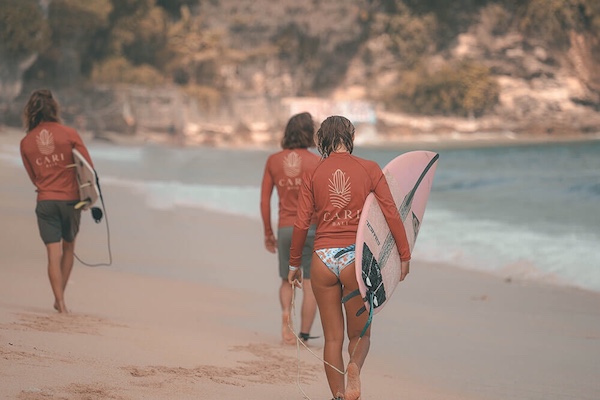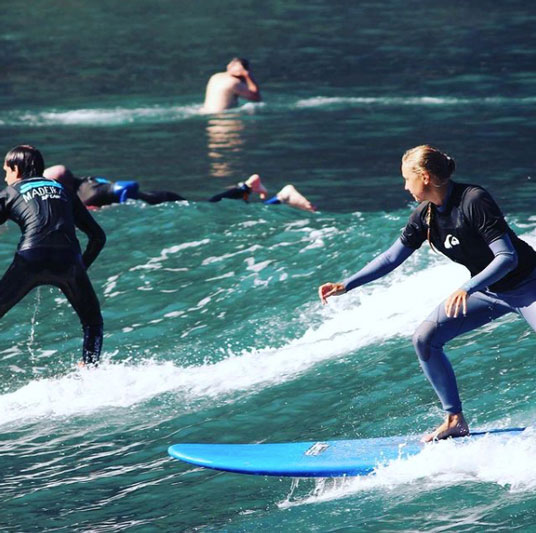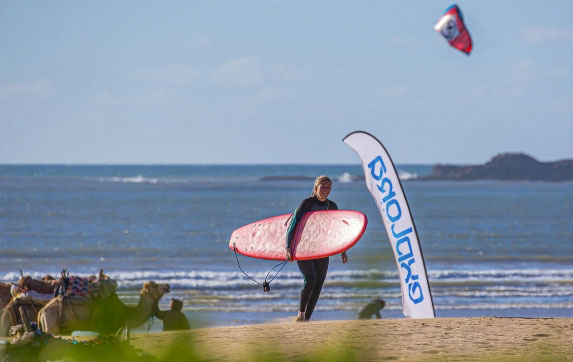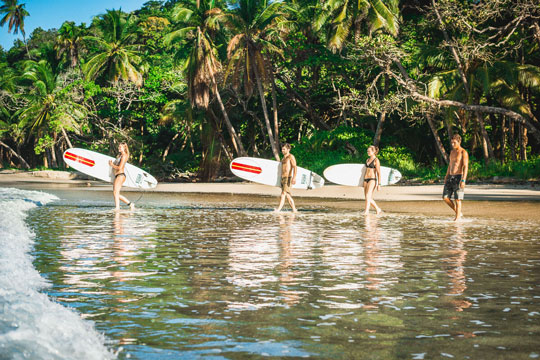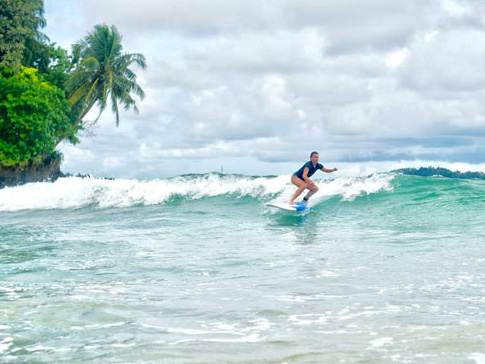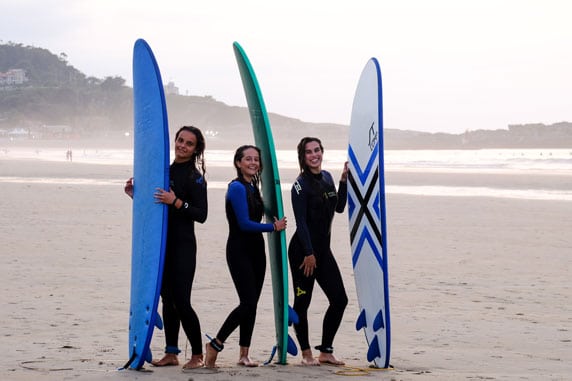Learn surfing-
Everything you need to know
Tips and information about how to learn surfing
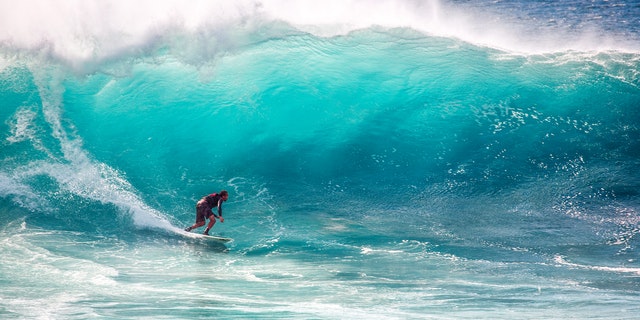
You’re absolutely sure you want to learn surfing! Feel the incredible sensation of gliding over the water with a surfboard while the salty sea air drives through your hair. It almost feels like flying. No, this is not a dream! Many surfers describe their first time surfing like that! You want more info? Read all about “learn surfing” and book your surfing holiday in one of the coolest surf schools today and at absolutely unbeatable prices!
What is meant by learn surfing
It is early in the morning and today is “learn surfing” on the daily schedule. After an extensive breakfast in your surf school (more information about the topic surf school can be found in our Surf-School-GUIDE!) you can already see how the surf instructors get the jeeps or surf buses ready. All surf equipment is packed. Let’s go!
You will go with an entire surf group to a selected surf spot. Your surf instructor starts with a short theory session right on the beach. He explains the features of your surfboard and what the words “Fins”, “Leash” or “Goofy” are all about. In the background you can hear the waves rushing. All the time you feel and smell the salty sea air that surrounds you with a light pinch.
You and the whole group now start with a slight warm-up. Let’s go! Your surf instructor will send you all into the water. After several attempts to catch a wave, you finally manage it. You feel the energy and power that the ocean has. Just getting up at the surfboard doesn’t quite work out yet. But that doesn’t matter, after all you still have a whole week of surfing lessons ahead of you!
Where surfing began
About the origin of surfing is not quite sure until today. However, surfing is thought to have its origins in Polynesia.
The Polynesian were very skilled sailors and spread to the countless islands of the Pacific (Polynesian Triangle). These include Hawaii, Tahiti, Tonga, the Easter Islands or New Zealand. As a result, parts of Polynesian culture also spread. Part of this culture was also surfing and thus the history of learning how to surf began.
Learn surfing - The sport of kings
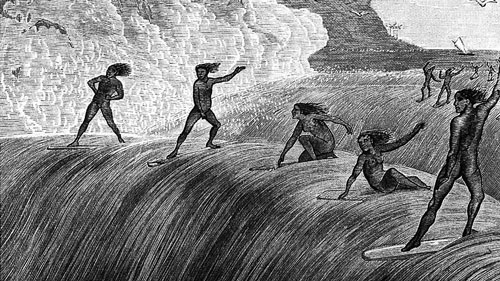
Through the Polynesian, surfing also came as far as Hawaii. There, surfing became an integral cultural as well as spiritual part of the population.
Both women and men practiced this “holy” sport Children have already started to learn surfing. However, the best waves on the most beautiful beaches were reserved for the kings. Therefore, if you surfed a wave that belonged to a king, there was even the death penalty (but don’t worry, this is no longer the case with our surf school offers)!
The surfboards of that time were made only from special “holy trees” and consecrated by a religious ceremony. Apparently, at the beginning, you only limited yourself to the straight-forward ride in smaller waves (just as you will learn it in your surfing holiday at the beginning). But that should change later!
Learn surfing - The 19th century
British Captain James Cook discovered Hawaii in 1778. At that time he was fascinated by the Hawaiian people while surfing. This can be seen from some of his notes.
This was also the beginning of the European influence in Hawaii, which would later have consequences for surfing.
Hawaii was colonized with the help of Christian missionaries and surfing with its spiritual influence was declared pagan. The Hawaiians soon lost their cheerful attitude due to the strict European rules and even surfing moved more and more into the background, but never completely disappeared. Writers like Mark Twain mentioned surfing in their travelogues in 1866.
In the 19th century the situation changed again!
A name stands out – Duke Kahanamokuor also called “the big Kahuna”! Not only did he win the Olympic Swimming Olympia Tirel three times, but he was also a co-founder of modern surfing.
Following the example of the Polynesians, he travelled a lot around the world and was able to make his passion for learn surfing known in other countries.
Hawaii also became an increasingly tourist destination, and as a result, many people also came into contact with the topic of surfing. This was the rebirth of surfing!
Why you should learn to surf
With the topic of learn surfing, you combine a very special lifestyle! Surfing is directly related to Mother Nature. Especially the ocean and the beach take centre stage here.
But learn surfing means so much more: You learn to go to both your physical and emotional limits. Adrenaline and an absolute high feeling will be your constant companions. There is even a word for this – “stoked” under the language of the surfers! The term describes on the one hand that one is physically exhausted by this special sport, but feels an immense feeling of happiness.
Learn surfing means sun, beach, sea, adrenaline, happiness and fun!
Learn surfing in one of our partners surf schools, you can see in the following video (read also our surf school guide)
Learn surfing for beginners - What to look out for
Surfing is definitely a sport where you never stop learning. Many surfers who have been surfing since their earliest youth will confirm this. Every surf spot and every wave is different and therefore you will always find slightly different surfing conditions. Nevertheless, there are some things to know.
How a wave is born
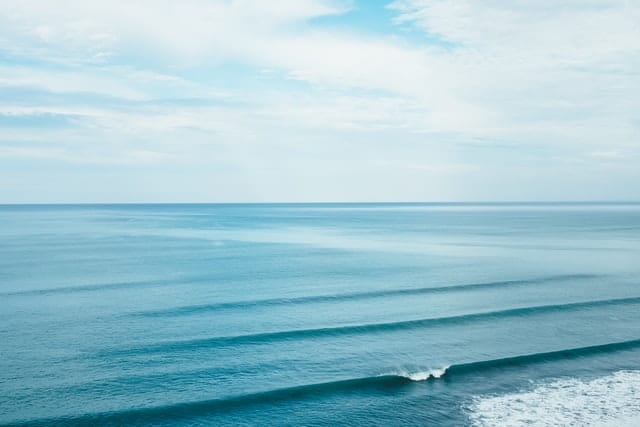
The formation of waves is basically a physical process that depends on many factors. In principle, however, wind is the main cause of waves.
Waves are often caused by the fact that wind blows over the surface of the water on the open ocean and thus transfers its energy to the water. The stronger and longer the wind, the greater of course the waves.
A distinction is made between waves that form far out on the ocean and often travel over several 1000 km (ground swell) or waves that arise over local winds (wind swell). Ground swell waves have a wave period of mostly over 15 seconds and are considered the “Creme de la Creme waves” among surfers.
Of course, there are other factors to consider when waves are born. These include the tides, currents, seaquakes or the seabed.
The local winds are also an important factor. When the wave arrives, they decide on another quality feature which is dealt with under the topic “Which wind direction while surfing – onshore or offshore”.
Which wind direction while surfing - onshore or offshore?
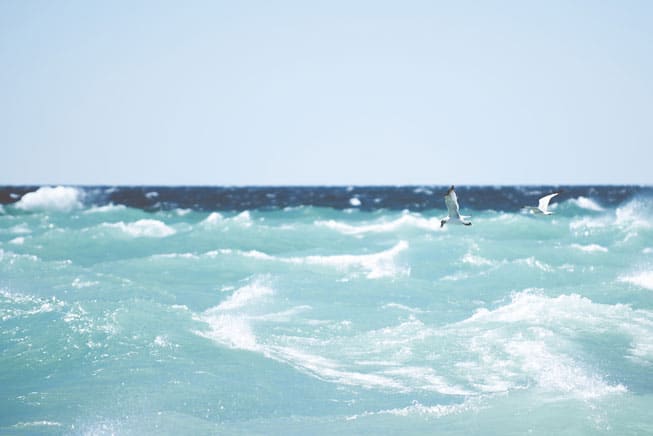
The wind direction of the local winds plays a decisive role when you learn surfing Depending on the direction from which the wind comes, a distinction is made between “onshore” and “offshore”.
Onshore:
The term onshore refers to the wind blowing from the sea towards the coast and is rather not preferred by surfers. Onshore wind pushes into the wave from behind. As a result, the wave breaks faster and a lot of white water forms.
Offshore:
This is the wind direction that every surfer is looking for! Offshore wind blows from the coast towards the sea, pushing the “face” of the wave from the front. This keeps the wave open longer and is practically cleaner for surfing.
There is also the so-called “sideshore” wind. The wind blows from the side here and is an intermediate stage to the on- and offshore wind.
(Maybe you are also interested in how to learn windsurfing, learn kitesurfing or learn wing foiling !)
Which surfboard to learn surfing?
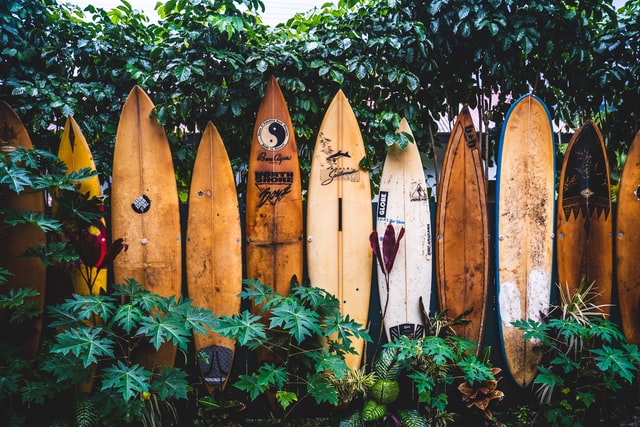
Which surfboard is the right to learn surfing? The topic of surfboard has a history of at least as long as the topic of surfing itself.
The Polynesians or Hawaiians mentioned at the beginning used very large surfboards made of hardwoods. These often weigh between 50 and 60kg!
In the 1930s, balsa wood was used to build surfboards. This made the surfboards much lighter. In the 1960s the famous “foam” or hard foam was used. This was covered with fibreglass and impregnated with polyester or epoxy resin.
From that point on, the surfboards achieved an unprecedented performance. The individual surfboard types were also evolutionized. Today we talk about softboards, longboards, shortboards, funboards or guns, etc. Each surfboard is designed for a different surf level as well as a different wave type.
Which surfboard do you use to learn surfing? In general, it is recommended to use a so-called “softboard”. Why a softboard? Its construction gives you the best stability for the first standing attempts. In addition, the core is covered with a soft foam and therefore protects against possible injuries. The surfboard fins are also made of flexible plastic.
Therefore, surf beginners always use softboards at the beginning. But they can also be a lot of fun for advanced surfers!
Choosing the right surf spot
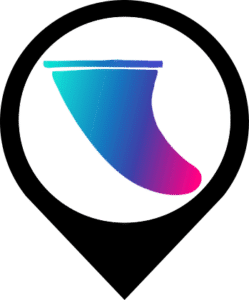
Choosing the right surf spot while surfing is a very important topic, especially at the beginning. If you have booked your surfing holiday in one of our partner surf schools, your surf instructor will take care of the optimal surf spot selection.
If you do your surf trip alone, you should always inform yourself well about the respective surf spot in advance. The surf spot and your surf level should be coordinated.
Tip: Observe the surf spot always well before!
- Observation time about 10 min
- At what point do other surfers go into the water?
- How big are the waves and where do they break?
- Are there dangerous rocks or sandbanks?
If in doubt, ask local surfers what to look out for!
On your first surfing attempts you should rather choose smaller waves. Beachbreaks and white water waves are very suitable for learning to surf As a beginner, you surf the white water of the already broken wave. This breaks into approximately chest-high water and gives you enough time towards the beach for your first standing attempts.
If you already have balance on the surfboard and stand easily while a wave pushes you, you can already think about “green waves”. The term green wave is the unbroken wave. You then drive them off sideways as long as the conditions allow you.
Green waves are the real goal when you learn surfing. But don’t forget: choose smaller waves at the beginning rather than too big! After all, it’s all about the right technique while surfing, especially for beginners. In addition, too big waves can also pose a safety risk for a surfing beginner.
Learn surfing - Paddle right
A key criterion while you learn surfing is the right paddle technique. Because without speed it is hardly possible to catch a wave!
- Position on the surfboard
The correct position when paddling is an important factor. If you are too far behind on the surfboard, it is impossible to gain speed. Also, all the weight is shifted to the rear area and the power of the wave does not transfer to your surfboard.
The opposite would be if you were too far ahead. Also here you don’t get the right speed, but the full power of the wave is transferred to your surfboard nose. Your weight is too far ahead and let you make a “Nosedive”! Therefore, your body weight should be in the middle.
- Body tension
Just as important when paddling is a certain body tension. Without this, the balance is not given during paddling. In addition, the right body tension also increases the speed.
So what to consider:
The upper body is slightly upright (as with the cobra’s yoga exercise) and the buttocks are tense. It is very important that the feet are also raised and remain together. You can also cross your feet so that they don’t always open automatically. So you have distributed the weight optimally on your surfboard and the next wave belongs to you!
- Paddling
Dive with your arms properly under water and pull them strongly past the rails. Many people make the mistake and “stroke” the water. You want to build speed when paddling and that can only be done with powerful paddle movements. However, in order to save strength, it is important that your paddle movements are calm and controlled. You don’t have to be like a speedboat.
The "holy" take-off
The take-off or “pop-up” is one of the most difficult things to learn while surfing. You mean the upward movement on the surfboard while a wave pushes you. But don’t worry, by the right surf instructors in our partner surf schools you’ll soon have the shoot out there.
There are different ways to practice the take-off. The important thing for you is that you find the best method for you. However, we would like to advise against one method: to use the knees during the take-off! Once you get used to it, it’s hard to get rid of it! Why without knees at the pop-up? In short: because this is not possible with shortboards. And finally you want to surf a shortboard at some point.
The Take Off briefly explains:
Important for the take-off or pop-up is that you lie correctly on the surfboard right at the beginning (see also “Learn surfing – Right paddling”). If you are too far behind or too far ahead on the surfboard, the take-off will not succeed.
Take-off techniques
There are various take-off techniques to learn while surfing. We would like to introduce you 2:
- The jumped take-off
You support yourself with your hands at chest height on the surfboard. You lift your upper body like a cobra and jump into a shoulder-width stand.
- The 2-3 Steps Take-Off
You support yourself again with your hands at chest height on the surfboard. Raise your upper body again like a cobra. This time, however, you use your legs and hips in a slight rotating movement to stand up. There are 2-3 support points spread over the whole surfboard which make it easier for you to stand up.
The important thing with both methods is that you always jump into the surfboard center in a shoulder-width stand. The feet always stand sideways for a better balance.
Don’t forget: Exercise makes the master! Practice the take-off therefore directly on the beach as well as in the water.
What else needs to be considered during the take-off?
Another important factor in achieving a successful take-off is the right position outside the line-up. If you don’t wait at the right point (also called “peak”), getting up on the surfboard will also be unsuccessful. But that you will learn in your booked surf school.
Search NOW for the best surf school to LEARN SURFING
You can find even more surf schools and surf camps to learn surfing here:
Surfvacationer.com offers you a huge selection of surf schools. New surf schools are added every day. If you want to learn surfing, you are certainly at the right place. Compare the various offers in Europe and worldwide and book your surfing holiday today.
The most common mistakes while learn surfing
Every beginning is hard! This is also the case when you are learning to surf. We would like to show you here the most common mistakes that can happen especially to beginners:
1. Learn surfing alone
One of the most common mistakes in learn how to surf is to want to teach yourself. Many people simply borrow a surfboard during their surfing holiday without knowing the basic rules or the respective surf spots.
However, this creates a risk of injury for oneself and others! Also remember that surfing is one of the coolest sports in the world. Without the necessary know-how, you will not achieve the fun factor that would be possible.
If you have never been on a surfboard, we recommend you to attend a surf course in a surf school (more information about surf schools can be found here).
2. The right surfboard
Another mistake many make while they learn surfing is choosing the right surfboard. Your surfboard should be adapted to your surf level!
As a surf beginner, you usually use so-called softboards. These consist of a soft deck and flexible fins. Most importantly, they ensure good stability through their construction.
A shortboard is only for the advanced surfer. These are more difficult to handle and require sufficient surfing experience.
Often you see in the line-up many who try to surf far too small surfboards.
Therefore: At the beginning, choose a larger and bigger surfboard rather than a too small one!
3. The right view while you are learn surfing
If you already master the take-off in the water and can stand on the surfboard, the view in the right direction is very important.
Many often look down at the feet or nose of the surfboard. However, it is important that you look in the direction where you want to surf. Why is that?
The direction of view is closely connected with how and where you are moving in the wave. If, for example, you already surf green waves sideways and adjust your view towards “Wave-Lip”, you surf automatically upwards. The opposite is the way you look towards the “Wave-Bottom”, which lets you surf down.
Where you surf when you look at your feet, you can probably imagine! We just say: “WIPE-OUT”!
4. Do not observe the rules while surfing - "DROP-IN"
As in daily traffic, there are also rules of priority to be observed when you are learning to surf.
The so-called drop-in (if you ride another surfer into his wave) is almost considered a mortal sin and is an absolute no-go!
It is worth mentioning that the drop-in is only possible in green waves that can be driven off to the side. In white water itself, this rule does not play a major role. But who has the right of way? You have to understand how a wave actually works. A wave always breaks at the highest point (at the “peak”). There the wave also has the most power and the surfer who starts from there has the longest way. This is exactly why the surfer who is closest to the peak, “owns” this wave.
If you now drop a surfer into the wave, you practically cut off the path. Therefore, it is impossible for him to surf the wave to the end.
Of course, while you learn surfing it can happen that you unintentionally disregard this important rule. Should a drop-in pass to you, you should definitely apologize (Surfer Honor Code)!
Learn surfing in your surfing holiday
If our little surfing guide gives you a real desire to learn surfing, you should book your next surfing holiday as soon as possible!
Best waves, absolute fun factor and cool new people!
Click through our offer and do it now: LEARN SURFING!
Surf course Bali – 8 days surfing incl. Accommodation, Yoga and Wellness
Surf, Yoga 0 review(s) 8 daysBook the ultimate surfing holiday and learn surfing! DO IT NOW!

